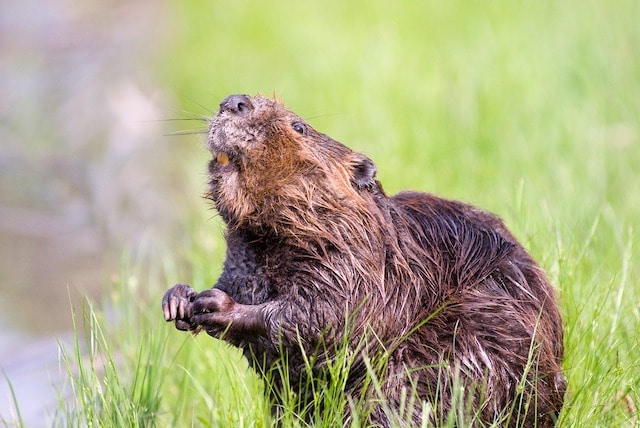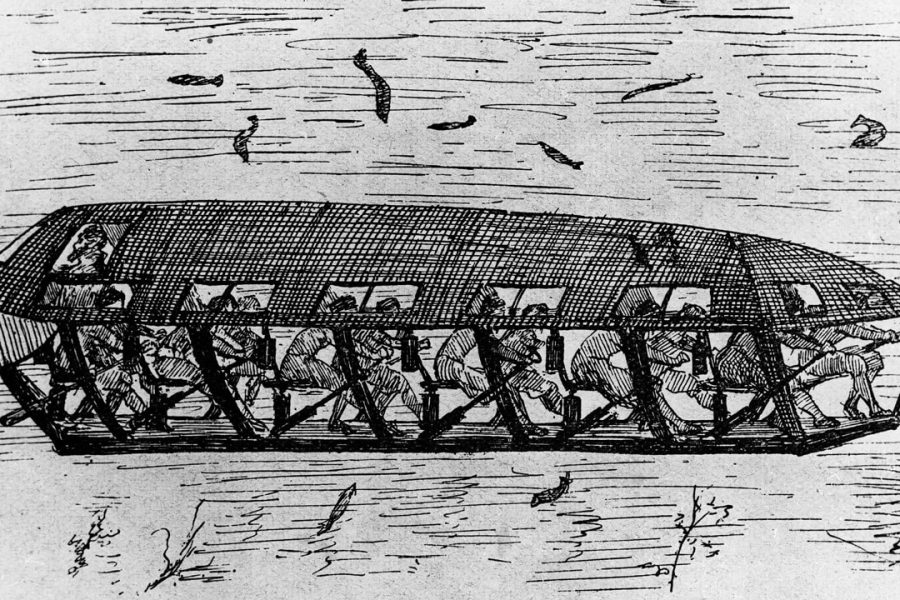We all know about woolly mammoths and saber-toothed cats, but evolution is such that all species have some pretty weird ancestors. Often, they don't look alike. From the least surprising to the most, here are 10 of the weirdest of them all.
10. Short-necked giraffe

The giraffe's prehistoric ancestor was about the size of an elk and had similarly large horns. At the sivatherium (along with bramaterium and others) had long necks to graze on treetops in Eurasia millions of years ago, but only about twice as long, than modern giraffes. However, it is believed that it was the largest ruminant animal (ungulate grazing animal) that has ever existed.
Interestingly, although fossil evidence dates it back millions of years, it may have survived much later. Not only rock paintings depict this animal, but a copper ring with reins, found by archaeologists during excavations of the ancient Mesopotamian city of Kish, also contains detailed image Sivatheria .
9. Waistcoat ant

Ants can be the most successful animal on Earth, making up to a quarter of the biomass in tropical regions and a fifth of the biomass overall. Ant family Formicidae There are over 9,500 species known to science, and an estimated 3,000–9,000 species yet to be described. They, too, have existed for millions of years and continue to live in harmonious symbiosis with their planet.
But little is known about how they came to be. The earliest fossils date back to the Middle Cretaceous period, just 100 million years ago, when their planetary dominion was still in its infancy. And there are few clues as to what came before. Instead, our best theories are based on comparing ants to modern species. Their hive-like colonies, for example, bear a resemblance to colonies of wasps and bees, especially given that they all tend to center on a single mother, the queen.
But there is one species of wasp that researchers believe the ant is most closely related to: the mud dauber. Female mud daubers are known to lay their eggs in carefully constructed cylinders of mud. They then find a victim, paralyze it, and seal it inside the nest with their eggs so that the larvae will have something to eat when they hatch. The first proto-ants are thought to have started out this way, too. "building simple nests and delivering food to their offspring." Then, as the offspring grew older, it may have helped the mother raise more.
8. Four-legged fish

It may not be that hard to imagine that frogs evolved from fish , but the intermediate creatures really did look bizarre. Ichthyostega was one of the first to live, 364 million years ago. It was in many ways a fish. It had scales, vestigial gill bones, and a dorsal fin running the length of its tail. But Icthyostega , which grew to three feet, also had four fleshy limbs, each with fingers, as well as strong ribs for living on land. Unlike fish, it also had lungs.
Apparently this trait emerged slowly. Most of them developed when ancestors Icthyostega were still entirely aquatic. Limbs, for example, gradually evolved from "lobed fins" , which looked like fleshy oars and served them. Lungs also probably evolved underwater.
7. "Adam and Eve" worm
Despite our differences, what all animals (except sponges and jellyfish) have in common isbilaterally symmetrical body (mirror left and right), and a front side with a mouth and a back side with an anus. We are "bilateral." And scientists believe that the earliest ancestor of all of us was a "flabby blob the size of a grain of rice" named Ikaria wariootia .
Discovered in the Australian outback from fossilized burrow tracks, it dates back to the Edicaran period (560-551 million years ago). It differs from other possible candidates, such as Dickinsonia , the presence of a mouth and intestines.
Thus, it is the ancestor of all other creatures on this list, as well as the creatures reading it.
6. Horned Horse
Prehistoric brontoteres occupied a special place in Sioux mythology. Known for its fossilized bones, it was called Thunder Horse and was said to have come down during a storm and trampled a buffalo. Whether this is true or not, brontoteres were indeed ferocious beasts - the largest mammals in all of North America during the Eocene.
For example, one species is 8 feet tall and 15 feet long. Megacerops , had a pair of long horns that he probably used for headbutting. Meanwhile at Emblotherium There was only one horn, long as a battering ram, with nasal bones. It is believed that it could have been used for loud vocalization over long distances.
All brontotheres became extinct by the end of the Eocene, but today their relatives include rhinoceroses, tapirs, and… horses! In fact, aside from their horns and their general description as rhinoceroses, they may have looked a lot like horses – at least in the head, due to their elongated skulls.
5. Ground sloth-meat-eater
The so-called "great beast of America" Megatherium americanum , was similar to modern sloths, only ten times larger. Weighing about the same as a bull elephant, it stood up to 12 feet tall on its hind legs. Needless to say, it lived on the ground, not in trees.
Unlike modern sloths, ground sloths ate meat in addition to plants to maintain their large size. But they probably ate from prey taken by big cats, wolves, etc., rather than hunting themselves.
They were still roaming the pampas of Argentina and other places in South America until the Holocene 8,000 years ago, living with early humans. In fact, humans are thought to have hunted the ground sloths to extinction. Although some think they have survived to this day .
4. Tall hornless rhinoceros
You may have heard of woolly rhinoceroses , which became extinct about 12,000 years ago. They were a common subject in cave paintings. As the name suggests, they all had woolly coats. And, curiously, one species of woolly rhinoceros had two horns instead of one.
But they were nothing compared tomighty Paraceratherium The rhinoceros' ancestor, which lived 35 to 20 million years ago and was over 26 feet long, was tall and had a long neck similar to a brontosaurus. It weighed as much as five adult elephants (15 to 30 tons). And, most bizarrely, for a distant rhinoceros ancestor, it had no horns at all.
It is believed that elephants (not people for a change) destroyed habitat Paraceratherium , stripping and chopping down trees, which led to the giant's disappearance. But there's still a lot we don't know about this dinosaur-like mammal. For example, we still haven't even pieced together a complete skeleton Paraceratherium .
3. Giant beaver

Imagine a beaver above man , weighing 200 pounds with six-inch incisors, and you can imagine the genus Castoroides This shaggy giant roamed the forests of North America between 3 million and 10,000 years ago, when humans are thought to have hunted them to extinction. It is likely that both their meat and fur were in demand.
Like the modern beaver, at castoroides had large gnawing teeth and fed on plants. It was also partly aquatic, probably because it was easy prey on land for predators such as the saber-toothed tiger.
However, it is not entirely clear whether they built giant dams. No evidence remains, except perhaps a four-foot height in Ohio .
2. The ferocious pangolin
The dominant carnivorous mammals 55-35 million years ago were creodonts , relatives of the modern pangolin. What makes this even more interesting for such a timid-looking creature is that Creodonta means "meat teeth," and pangolins don't have them. Instead, they pick up insects with their tongues, earning them the nickname "scaly anteater," despite the fact that are not related .
So what were the pangolin's phylogenetic ancestors? Of the approximately 30 species, perhaps the most impressive are hyaenodontids . Named for their hyena-like teeth, adapted for cutting flesh rather than clamping, these species hunted in packs like wolves, usually at night. Some of the larger hyaenodontids , such as 4.5 feet tall, 10 feet long and 1,100 pounds hyaenodon , perhaps hunting alone during the day.
1. Land whale

How do mammals get into the sea? Whales, dolphins, seals, walruses, etc. all evolved from species that once wandered on dry land . For example, pinnipeds (seals, walruses, and sea lions) are thought to have evolved from primitive bears, as are their land-dwelling relatives, the weasels, otters, and skunks. Meanwhile, sirens, or sea cows, are thought to be related to elephants, as well as to the most unlikely of elephant relatives, the hyrax.
But the most iconic group of ocean-dwelling mammals, the cetaceans (whales, dolphins, porpoises, narwhals), evolved from something unrecognizable—a creature that “ran like a wolf… roamed like a hippopotamus… put its ear to the ground , to hear distant rumbles… [and] to have cow's ankles." At Pakicetus had the body of a land mammal, but characteristic long skull whale. Hunting animals on both land and water, it lived along the edges of the shallow Tethys Sea 50 million years ago.














Оставить Комментарий